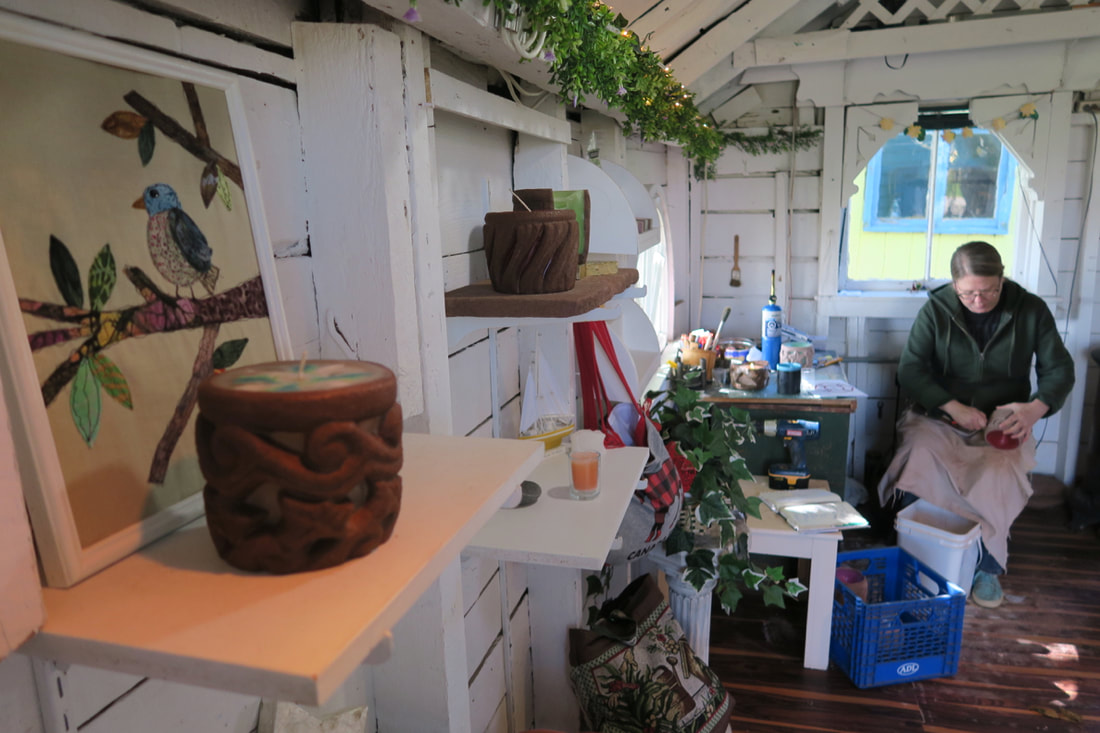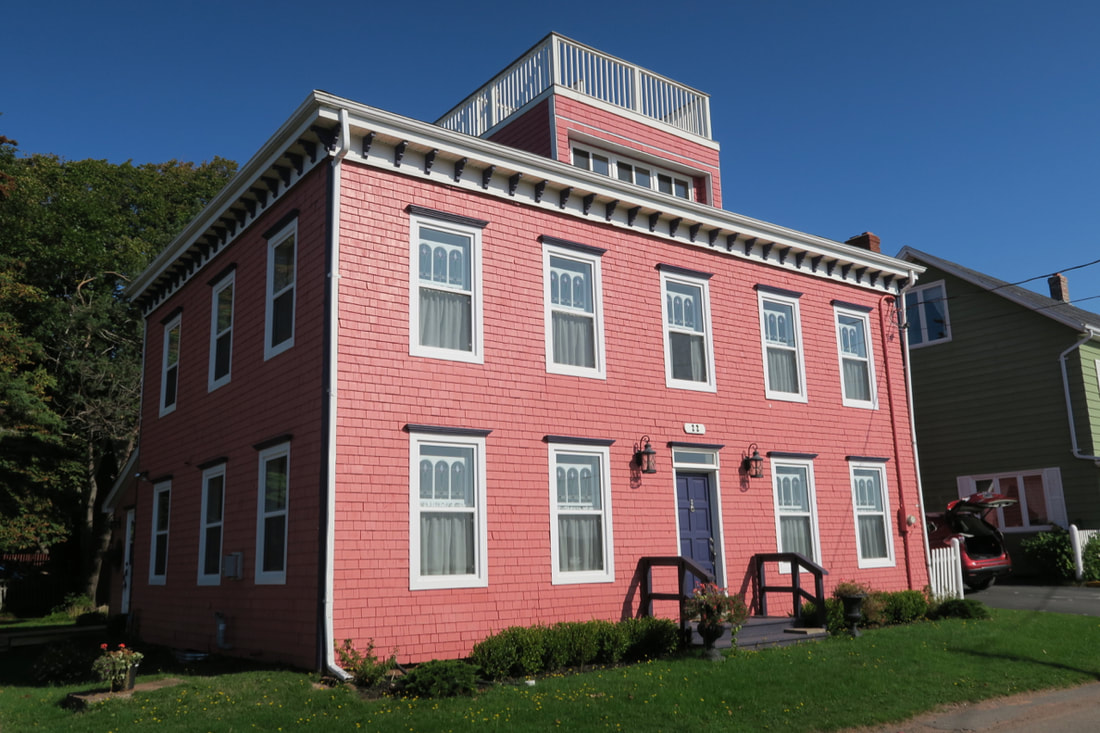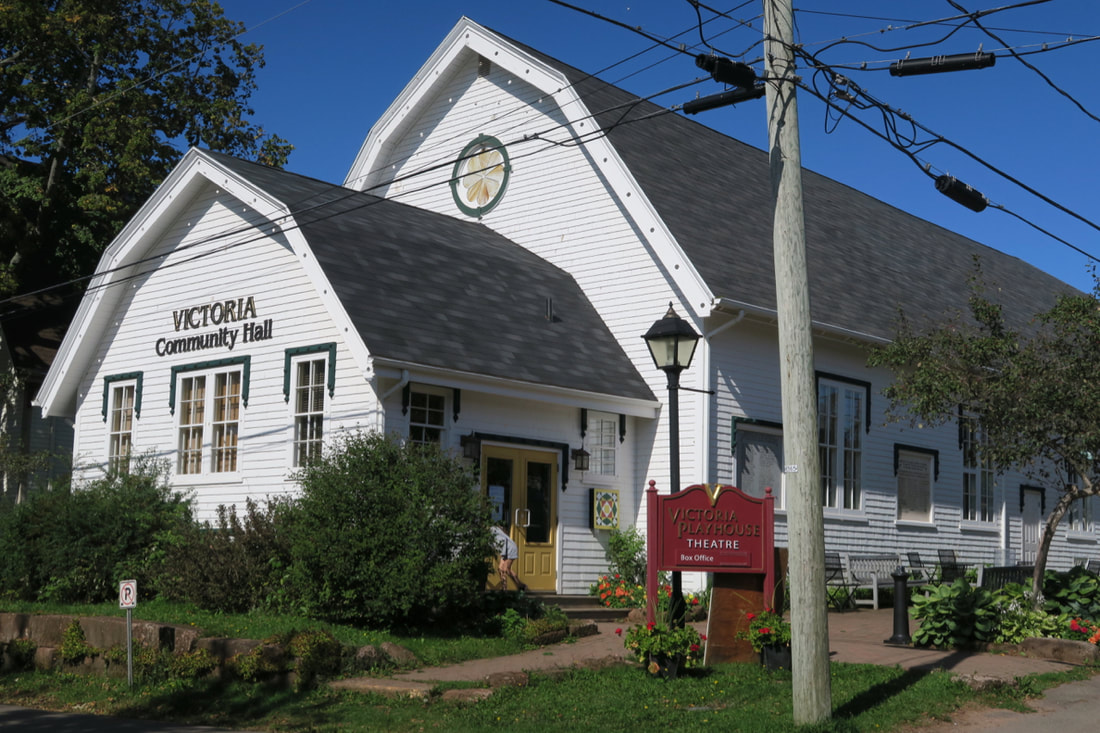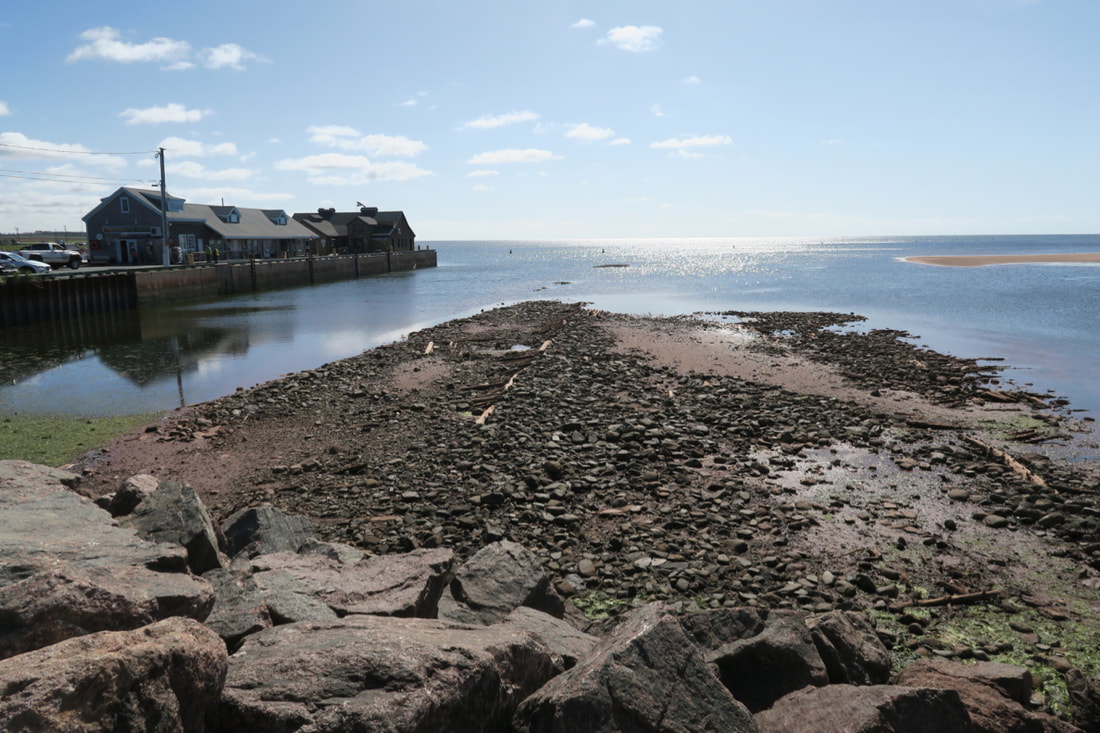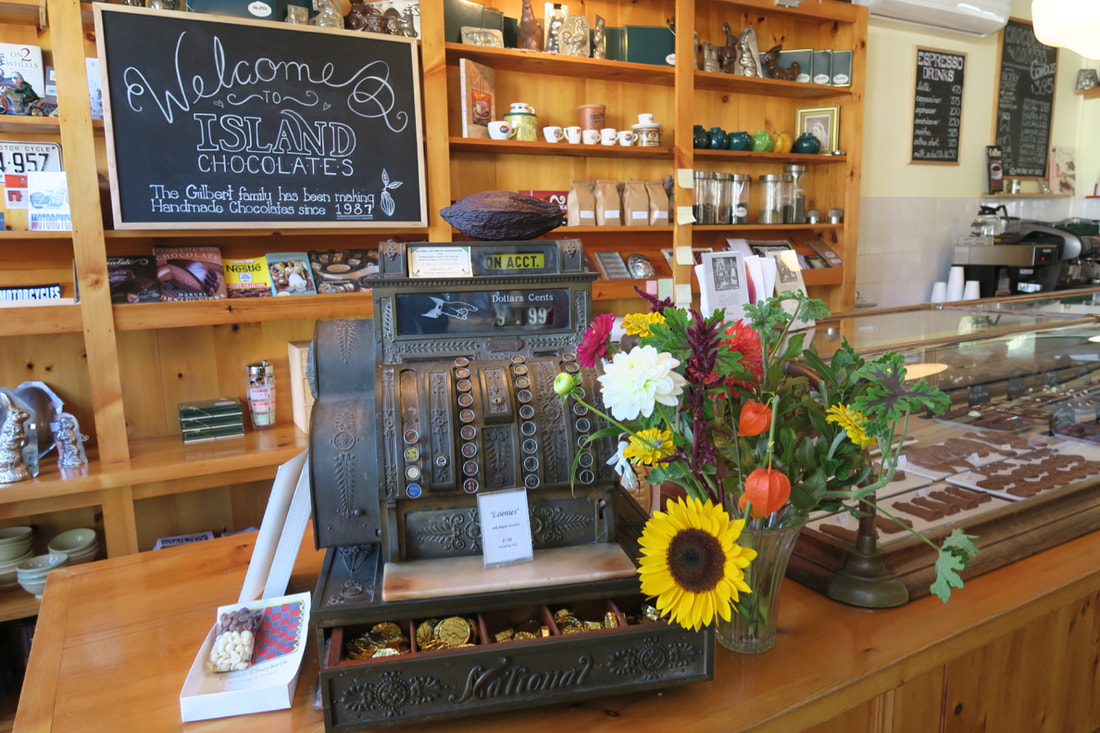The Boston Globe: Put Victoria-by-the-Sea on your must-see bucket list
We arrived mid-morning on a sparkling, pre-pandemic late-September day when the saturated colors of the red clay sand, cloudless cerulean sky, Technicolor green grass, and sparkling sea were matched by buildings painted pink, violet, aqua, ochre, and emerald. Amid all the color, we were drawn to a solitary white and red lighthouse. Finding it locked, we began to walk away until spotting a man in a cable-knit sweater hustling toward us, keys in hand. Ben Smith, a year-round resident, had seen us looking and came to open the door. The still operating 1879 lighthouse (open “by chance” with admission by donation) doubles as the Victorian Seaport Museum, where a wall-mounted selection of photos and text details the village’s seafaring history.
On previous visits to PEI — for lobster-, oyster-, chowder-, and mussel-eating at the annual International Shellfish Festival — I had somehow missed this gem of a town. How tiny is it? I put this question to Smith.
“We’re a village of 100 people. In the summer, it goes up by about 50,” said Smith.
“We’re a village of 100 people. In the summer, it goes up by about 50,” said Smith.
Coming from a Cape Cod town where the population jumps from about 3,500 to 17,000 at the height of the summer season, I was taken aback, thinking perhaps I hadn’t heard correctly. But the number was confirmed by Christine Smith, Ben’s daughter, who along with her father operates Enchanted Candles, a shop selling intricately carved sandcast candles, delicate beaded mobiles, and other crafts in the Sea Nest, a toy-size one-room cottage.
“This building was originally part of a fox farm,” she said, when asked about the room so small I could reach up and touch the rafters. “It was dragged over here by the fire department. Once you have a shop in your yard, you’re in business!”
Located a 30-minute drive from the capital city of Charlottetown, an area on the south shore of the island referred to as the Red Sands Shore, the village then simply called Victoria was founded in 1819. By the end of that century it was a prosperous fishing seaport with a sheltered harbor from which schooners shipped the island’s bounty to far flung locales. As the 20th century dawned, the development of roads and highways shifted modes of commercial transportation away from the sea, leaving the town off the grid from major commerce.
“This building was originally part of a fox farm,” she said, when asked about the room so small I could reach up and touch the rafters. “It was dragged over here by the fire department. Once you have a shop in your yard, you’re in business!”
Located a 30-minute drive from the capital city of Charlottetown, an area on the south shore of the island referred to as the Red Sands Shore, the village then simply called Victoria was founded in 1819. By the end of that century it was a prosperous fishing seaport with a sheltered harbor from which schooners shipped the island’s bounty to far flung locales. As the 20th century dawned, the development of roads and highways shifted modes of commercial transportation away from the sea, leaving the town off the grid from major commerce.
Looking at history with 21st-century eyes, this shift could be what saved the town from overdevelopment, and is what makes it special today. Along a six-square-block grid, the historic architecture remains. Lovingly preserved homes and public buildings have been converted into boutique shops selling all manner of crafts — pottery, jewelry, textiles, woodwork, rug weaving, handspun yarns, stained glass, soaps — as well as antiques, handmade chocolates, clothes, toys, and gifts. The Victoria Playhouse, a former hall for community events circa 1914, presents contemporary drama, comedy, storytelling events, and musical concerts during its summer season. It all seems very turn-of-the-last century, without feeling fake or precious.
Most visitors are day-trippers who arrive to shop, dine, and stroll for all or part of the day. The tourism season runs from mid-May, weather permitting, to sometime in October when the town hosts an early Christmas stroll. (Or, as one shopkeeper told me, “I stay open until I have to turn on the furnace.”) Those who want to linger longer can stay in a historic seven-room bed and breakfast, the Orient Hotel, or in one of several one-, two-, and three-bedroom holiday cottages.
Most visitors are day-trippers who arrive to shop, dine, and stroll for all or part of the day. The tourism season runs from mid-May, weather permitting, to sometime in October when the town hosts an early Christmas stroll. (Or, as one shopkeeper told me, “I stay open until I have to turn on the furnace.”) Those who want to linger longer can stay in a historic seven-room bed and breakfast, the Orient Hotel, or in one of several one-, two-, and three-bedroom holiday cottages.
Most visitors are day-trippers who arrive to shop, dine, and stroll for all or part of the day. The tourism season runs from mid-May, weather permitting, to sometime in October when the town hosts an early Christmas stroll. (Or, as one shopkeeper told me, “I stay open until I have to turn on the furnace.”) Those who want to linger longer can stay in a historic seven-room bed and breakfast, the Orient Hotel, or in one of several one-, two-, and three-bedroom holiday cottages.
Restaurants serve local island fare in casual settings. Overlooking the harbor, the Lobster Barn Pub & Eatery offers lobster rolls, fresh local shellfish and seafood, po’ boys, burgers, salads, and other traditional pub favorites along with island craft beers. Also on the wharf, Casa Mia by the Sea serves up hearty breakfasts, lunches, and dinners made with island-fresh ingredients. On Main Street, Richard’s Fresh Seafood features — no surprise — fish shack favorites such as lobster rolls, fish and chips, and steamed mussels and clams. The menus may be simple but, this being PEI, the quality of the produce, meat, and seafood shine. Further along Main Street, the Landmark Oyster House serves a French-inspired, east coastal lunch and dinner menu. Swoon-worthy seafood chowder, fish cakes, braised pork ribs, and PEI beef burgers are some of the offerings, as well as a changing selection of newly-harvested island oysters.
For experiences in the surrounding natural environment, By-the-Sea Kayaking offers one-stop shopping for adventure opportunities. In addition to kayaking tours at various times of day and night (full moon paddle, anyone?), visitors can also rent paddleboards (with or without lessons) and hybrid bikes (with or without added picnic lunch basket). Or sign up for a clam digging excursion that involves kayaking out to the Tyron Shoal at low tide followed by fresh beach side chowder on your return.
For experiences in the surrounding natural environment, By-the-Sea Kayaking offers one-stop shopping for adventure opportunities. In addition to kayaking tours at various times of day and night (full moon paddle, anyone?), visitors can also rent paddleboards (with or without lessons) and hybrid bikes (with or without added picnic lunch basket). Or sign up for a clam digging excursion that involves kayaking out to the Tyron Shoal at low tide followed by fresh beach side chowder on your return.
Before leaving we stopped by Island Chocolates, a family-run operation in what was once a general store. In addition to luscious chocolates in all shapes and sizes (lobsters, lighthouses, musical instruments, motorcycles, fish), visitors were enjoying decadent desserts and something called “factory coffee,” a Belgian chocolate-lined glass with fresh custom-roasted coffee and whipped cream.
With delights like this throughout the village, perhaps Victoria-by-the-Sea deserves a “bucket list” designation after all.
Visit www.tourismpei.com for more information.
Necee Regis can be reached at neceeregis@gmail.com
With delights like this throughout the village, perhaps Victoria-by-the-Sea deserves a “bucket list” designation after all.
Visit www.tourismpei.com for more information.
Necee Regis can be reached at neceeregis@gmail.com



